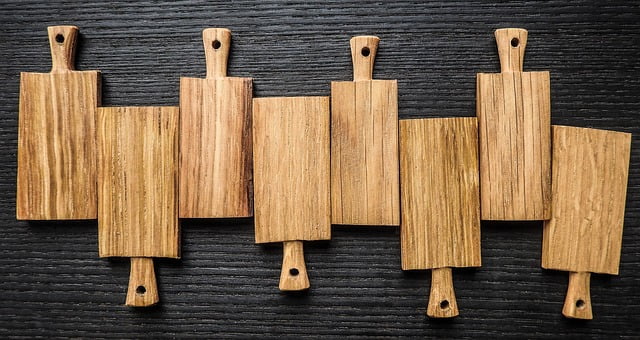
Acacia wood is highly suitable for cutting boards due to its durability and natural antibacterial properties. Its dense grain prevents scratches and keeps knives sharp.
Exploring the ideal materials for kitchen tools, acacia wood stands out as a top choice for cutting boards. Chefs and home cooks alike appreciate this hardwood for its strength and resistance to wear. Unlike some softer woods, acacia doesn’t easily scar, which helps ensure its longevity and makes it a hygienic option, as fewer grooves mean fewer places for bacteria to hide.
The wood’s natural oils also contribute to its resistance against moisture and mold, fortifying it against the common pitfalls of kitchen use. Additionally, acacia cutting boards are attractive, displaying rich, varying grains and warm tones that complement any kitchen aesthetic, blurring the line between utility and artistry. Given these benefits, it’s no wonder acacia wood is a preferred material for those who take their culinary tools seriously.
The Beauty Of Acacia Wood
When envisioning the ideal kitchen, one imagines a blend of practicality and aesthetic appeal. Acacia wood, a relatively unsung hero in the realm of culinary tools, marries these qualities beautifully in the form of cutting boards. Not only is it a functional asset for any chef or home cook, but acacia wood brings an allure to your countertop that few other materials can match.
Characteristics Of Acacia Wood
Acacia wood stands out for its hardness and durability, which translates to commendable performance in kitchen environments. Resistant to wear and tear, acacia is a reliable material for cutting boards, safeguarding your knives while offering a steadfast cutting surface. Below are key attributes that define its excellence:
- Dense structure: Impervious to scratches and dents.
- Moisture resistance: Naturally repels water, preventing warping and cracking.
- Antibacterial: Acacia’s density acts as a barrier against bacteria, making it a hygienic choice for food preparation.
Durability
One of the hallmarks of acacia wood is its resilience. A cutting board made from this hardwood can withstand the demands of chopping, slicing, and dicing without succumbing to premature damage. It’s not uncommon for acacia cutting boards to remain in excellent condition for years, as long as they’re maintained with proper care.
Attractive Grain Patterns
Each acacia cutting board is unique, displaying rich and varied grain patterns that are naturally elegant. This pleasing visual texture adds a touch of warmth and rustic charm to your kitchen, elevating the look of your workspace while serving a practical purpose. The lustrous finish of acacia wood, when oiled, can make it a showpiece when not in use.
Sustainability
A crucial aspect of choosing kitchen tools today is their impact on the environment. Acacia wood is a sustainable choice, often sourced from managed forests where trees are replanted to ensure a balanced ecosystem. This mindful approach to woodland management makes acacia wood cutting boards an eco-friendly addition to your kitchenware collection.
Is Acacia Wood Suitable For Cutting Boards?
When selecting the perfect cutting board for your kitchen, the material is a crucial factor. Acacia wood is frequently lauded for its durability and aesthetic appeal—but does it cut culinary prepping? In this guide, we delve into the key attributes that make acacia wood a strong contender for your chopping tasks.
Hygienic Properties
Acacia wood boasts an impressive density, which helps in keeping bacteria at bay. Unlike more porous materials that trap food particles and moisture, acacia’s tight grain provides a non-porous surface, reducing the opportunities for bacteria to grow—a vital characteristic for maintaining a hygienic cutting area.
Natural Antibacterial Qualities
The natural oils found in acacia wood grant it antibacterial properties, essential for food safety. These oils serve as a barrier, preventing the growth of common foodborne pathogens and allowing peace of mind as you slice and dice your produce and meats.
Water Resistance
Acacia’s resistance to water is noteworthy. This trait minimizes the risk of warping and cracking, thereby extending the cutting board’s life. This resistance is especially crucial in a kitchen where the board will be subject to frequent washing.
Kitchen Safety
Kitchen accidents often happen during hasty chopping or when using an unstable cutting board. Acacia wood’s weight and stability make it a safer choice, as it’s less likely to slip or slide on countertops while in use.
Knife-friendly Surface
Acacia offers a balance of firmness and gives, maintaining a knife-friendly surface that will not dull blades prematurely. This presents a fine compromise between protecting your knives and offering a solid cutting base.
Impact On Blade Sharpness
Unlike some harder woods or materials like glass which can blunt knife edges, acacia wood is kinder to your cutlery. A regular honing routine, paired with an acacia wood cutting board, will keep your blades in optimal condition for precise cuts every time.
Maintenance And Care For Acacia Wood Cutting Boards
Acacia wood stands as a favorite for kitchen enthusiasts and professional chefs alike when it comes to cutting boards. Its durability and beautiful grain make it not just a practical choice but also an aesthetically pleasing one. To ensure that acacia cutting boards last while retaining their natural beauty, proper maintenance and care are crucial. Attention to cleaning, drying, and seasoning methods will help to preserve the quality and longevity of your acacia wood cutting board.
Proper Cleaning Methods
Keep your acacia wood cutting board in top shape with the following cleaning tips:
- After each use, gently scrub the board with a combination of warm water and mild dish soap.
- Use a soft sponge to avoid scratching the wood’s surface.
- Rinse thoroughly with water, but avoid soaking the board, which can lead to water damage over time.
Avoiding Harsh Chemicals
To maintain acacia wood’s integrity, it’s important to steer clear of harsh chemicals that can strip its natural oils. Avoid using bleach or abrasive cleaners. For natural disinfection, a diluted vinegar solution can be an effective alternative.
Drying Techniques
Proper drying prevents water retention, which is vital for avoiding bacteria build-up. Follow these steps:
- Wipe the board with a clean, dry cloth after washing.
- Stand the board on its edge in a well-ventilated area to allow air to circulate and facilitate even drying.
- Avoid drying in direct sunlight, which can lead to warping.
Seasoning And Oiling
Seasoning your acacia cutting board helps to maintain its luster and creates a protective barrier that repels water and prevents drying. Use food-grade mineral oil or a specialized wood conditioner for best results. Apply the oil evenly, let it soak in, and wipe away any excess. Repeat this process every few months or whenever the board looks dry.
Preserving Wood Quality
Consistent care keeps acacia wood resilient. Avoid extreme temperature changes, which can cause the wood to expand and contract, potentially damaging its structure. Always store the cutting board in a cool, dry place away from heat sources such as stoves or heaters.
Preventing Cracks And Warping
The risk of cracks and warping can be minimized with proper storage and handling. Never dishwasher acacia wood boards, as the heat and prolonged water exposure can lead to these issues. Handwashing and following the aforementioned drying techniques play a crucial role in preserving the shape and structure of your cutting board.
Environmentally Friendly Aspects Of Acacia Wood Cutting Boards
As consumers become more eco-conscious, the choice of kitchen tools like cutting boards transitions towards sustainability. Acacia wood emerges as a standout material for cutting boards for its durability and natural beauty, but its environmental benefits are equally impressive. Let’s delve into why acacia wood is a green choice for your kitchen.
Sustainable Sourcing
Acacia wood comes from trees that are renowned for their fast growth and ability to thrive in challenging environments. Due to their rapid regeneration, acacia trees are a sustainable resource, ensuring continuous supply without depleting natural forests. Products made from acacia wood, like cutting boards, support the sustainable management of resources.
Responsible Forestry Practices
Harvesting acacia wood for cutting boards is often done through ethical forestry practices. These practices include selective cutting to maintain forest ecosystems and planting more trees than are harvested. This approach ensures a balance is maintained between industry needs and conservation efforts.
Positive Impact On Ecosystems
Acacia trees play a crucial role in their habitats. They help in the restoration of degraded lands and promote biodiversity by providing habitats for various species. Using acacia wood for your cutting board indirectly supports these positive environmental contributions.
Carbon Footprint Comparison
| Material | Carbon Footprint |
|---|---|
| Acacia Wood | Lower |
| Plastic | Higher |
When compared to synthetic materials, like plastic, the carbon footprint of acacia wood cutting boards is significantly lower. Acacia trees sequester carbon from the atmosphere, and this benefit continues even after they’re transformed into household items.
Environmental Benefits
- Reduced deforestation impact
- Conservation of natural habitats
- Lower greenhouse gas emissions
The overall environmental benefits of using acacia wood cutting boards are clear. From reducing the impact of deforestation to conserving natural habitats and lowering greenhouse gas emissions, acacia wood is an eco-friendly option for the eco-conscious consumer.
Biodegradability
Unlike plastic counterparts, acacia wood cutting boards are completely biodegradable. At the end of their long service life, they can be composted, returning to the earth without leaving harmful residues. This natural cycle minimizes waste and promotes a healthier environment.
Conclusion: Embracing Acacia Wood Cutting Boards For A Sustainable And Safe Kitchen
Acacia wood cutting boards offer a combination of durability, hygiene, and environmental friendliness, positioning them as a superior choice in modern kitchens. This final section summarizes the advantages and encourages informed purchasing decisions.
Recap Of Benefits
Acacia wood, with its natural beauty and resilience, provides several benefits. It’s not just about aesthetics; their functional advantages stand out as compelling reasons for their selection as cutting boards.
- Exceptional durability
- Resistance to scratches and cuts
- Natural antibacterial properties
- Minimal upkeep required
Durable And Hygienic
Acacia wood’s hard surface resists knife marks, which in turn, supports hygienic food preparation. The wood’s density prevents bacteria from penetrating the surface, safeguarding against contamination.
Environmental Considerations
Choosing acacia wood reflects a commitment to sustainability. Fast-growing acacia trees mean the wood is replenishable, reducing the environmental impact. Acacia cutting boards are eco-friendly kitchenware essentials.
Making Informed Consumer Choices
Customers should consider the origin and harvesting practices of acacia wood products. Opt for certified sources that ensure responsible forestry, embodying the ethos of conscious consumerism.
Inclusion Of Acacia Wood In Kitchenware
The inclusion of acacia wood in kitchen collections not only adds warmth and natural elegance but also contributes to a sustainable lifestyle. Its versatility and functionality make it a prudent choice for anyone looking to enhance their culinary workspace.
Frequently Asked Questions For Is Acacia Wood Good For Cutting Board
Are Acacia Wood Cutting Boards Safe?
Yes, acacia wood cutting boards are safe for use in food preparation. They have natural antibacterial properties and are highly durable, making them ideal for kitchen use.
Is Acacia Or Maple Better For Cutting Boards?
Acacia is harder and more water-resistant, making it a durable cutting board choice. Maple offers a more traditional look and self-healing properties, ideal for knife edges. Both are excellent options, but acacia’s toughness suits heavy use.
Is Bamboo Or Acacia Better For Cutting Board?
Bamboo cutting boards are eco-friendly and lightweight, while acacia offers durability and rich grain patterns. Acacia’s hardness often makes it the better choice for longevity.
What Wood Should Not Be Used For Cutting Boards?
Avoid using soft, porous woods like pine for cutting boards, as they can harbor bacteria and dull knives. Also, steer clear of woods with toxic properties, such as oleander or sassafras.
Conclusion
Selecting the right cutting board is key for any kitchen aficionado. Acacia wood, with its natural durability and antimicrobial properties, stands out as an excellent choice. Ideal for both casual cooks and professional chefs, acacia offers a balance of form and function.
Embrace the beauty and resilience of acacia wood for your cutting experiences.

